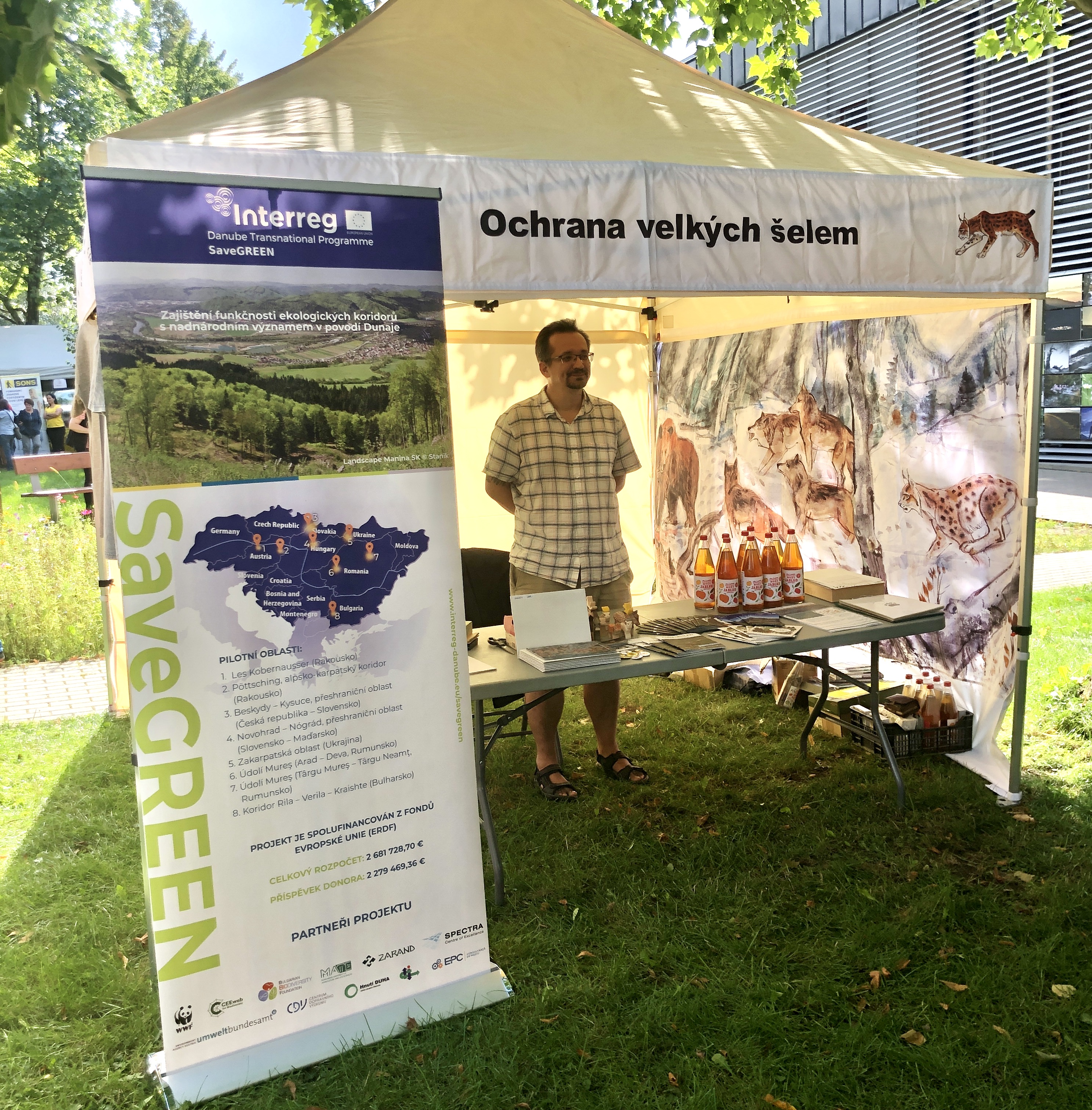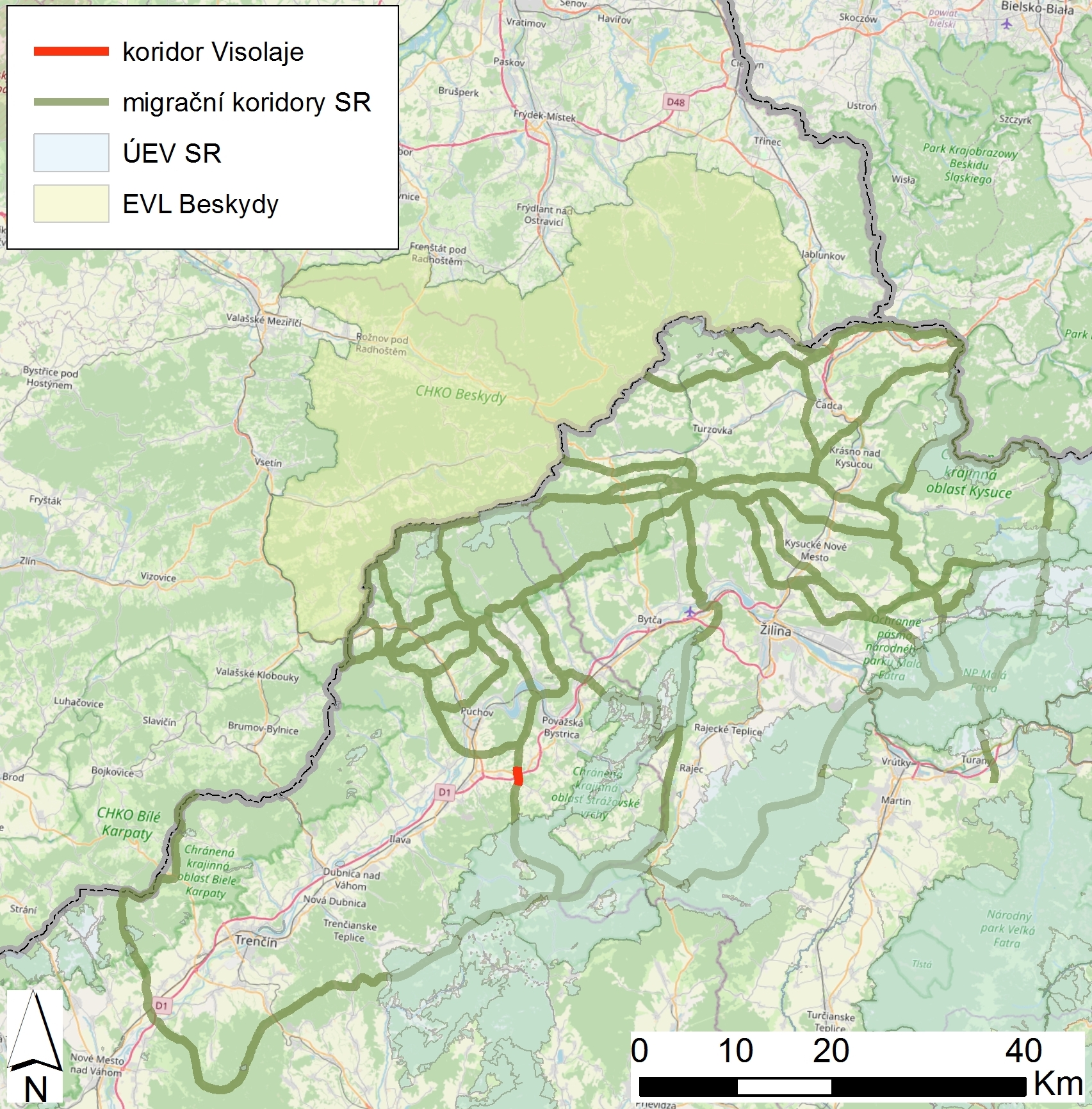SaveGREEN - An infoday dedicated to protection of ecological connectivity and large carnivores in Beskydy
08-11-2022
As previously introduced, the Beskydy Mountains are the last place in the Czech Republic with the regular presence of all three species of European large carnivores. Here as in the whole Carpathians, the carnivore populations are under severe threat from landscape fragmentation due to their large space demands and the need to move over long distances. That is why SaveGREEN info day was an important opportunity to talk about the need to preserve ecological corridors. The event place in Beskydy on the Czech-Slovak-Polish border where large carnivores from all three countries meet.
The information day took place in early autumn as part of the Apple Day festival in Jablunkov. At the Czech partner's large carnivore information booth, the team introduced the visitors to the topics related to lynx, wolf, and bear conservation and the problem of migration barriers. The event was organized as one of the activities of the SaveGREEN international project, in which we have been working together with other partners on the protection of landscape permeability in the Carpathians since 2020. Beskydy-Kysuce region is one of the 8 pilot areas of the SaveGREEN project.
Why Jablunkov?
Jablunkov, the town located between the Moravian-Silesian and Silesian Beskydy, was chosen for the event because it has long been an example of good practice in the protection of wildlife corridors for large mammals. One such corridor passes right by the town and is protected by local zoning plans. Also, as a traditional regional festival, Apple Day attracts visitors not only from the Czech Republic but also from Slovakia and Poland – the countries with which we share our large carnivore populations.
What did visitors learn?
At the information stand, visitors could learn all about the monitoring and occurrence of large carnivores in the surrounding mountains, about their lives, and the risks posed to their survival by the construction of new roads, highways, and urban development. Given the increased damages caused to local farmers by the wolf pack in recent months, livestock protection was also an important topic.
The visitors could also get a sneak peek into the methods of field research: tracking and collecting occurrence signs, GPS telemetry, and photo-monitoring of large carnivores. We also distributed brochures on large carnivores and landscape permeability or practical activities such as identifying animal tracks. During the project, the team developed several items and gifts to be able to engage more visitors through locally produced items, such as gift bottles of organic apple juice with labelled information about the goals of the SaveGREEN project.

Infoday in Jablunkov - photo: Anna Řezníčková
What are the goals of the SaveGREEN project in Beskydy?
The SaveGREEN project aims to identify, summarize, and promote the best solution for the protection of ecological corridors. The project outputs include an Operational Plan for each of the 8 pilot areas, so one dedicated to this area as well, that contains a description of the current state of landscape permeability, recommended measures for its improvement, and methods for monitoring the effectiveness of implemented measures. In addition, the Hnutí DUHA Šelmy (Friends of the Earth Czech Republic – Large Carnivore Conservation Programme) is monitoring and protecting the landscape permeability for various animal species, with a focus on large carnivores as an umbrella species, developing examples of good practice and transferring them to other valleys in the Beskydy Mountains and possibly other parts of the Czech Republic.
The main threats to the area involve several constructions planned in the ecological corridor in the Slovakian part of Beskydy that threatens protected carnivore populations.
A large private building covering a floor space of more than 1,600 m2 is to be built in the ecological corridor of large mammals in the Visolaje municipal area. The location is close to the Natura 2000 sites declared, among other objectives, for the protection of large carnivores such as wolves, lynxes, and bears. Preserving the remaining wildlife corridors between the mountain ranges is essential for the survival of these species on the Czech-Slovak border. Construction in the large mammal ecological corridor could threaten the Beskydy population of large carnivores. As the Trenčín district office has ruled out any impact on the Natura 2000 area, the Hnutí DUHA Šelmy (Friends of the Earth Czech Republic – Large Carnivore Conservation Programme) is asking for a cross-border assessment of the project and its impact on critically endangered animals.
The last ecological wildlife passages in western Slovakia are under threat following a particularly not-so-sufficiently planned decision made this year by the Trenčín district office. It concerned a development proposal in the Visolaje municipal area located approximately 20 kilometres from the Czech border. According to the project documentation, the development plan includes a parking house for 26 cars, an elevator, and a 400-metre-long access road. The floor area of an entire building will exceed 1,600 m2. The Trenčín office issued an opinion stating that the proposed construction will not affect the Natura 2000 protected areas, thus clearing the way for its implementation. This is despite the fact that the construction is planned directly in an important wildlife corridor, which was brought to the attention of district officials by the Strážovské vrchy Protected Landscape Area Administration and the Púchov district authority.
The nearby Natura 2000 sites were declared, among other objectives, for the protection of endangered large carnivores.
“We are calling for a transboundary impact assessment of the project. Contrary to the opinion of the Trenčín district authority, we fear that its implementation could have a significant impact on the Natura 2000 sites not only in Slovakia but also in the Czech Republic. This includes threats to the populations of critically endangered lynx, wolves, and bears,” - said Michal Bojda, a field worker of the Hnutí DUHA Šelmy, about the development plans in the wildlife corridor.
Slovak conservationists also dispute the decision of the Trenčín district office.
“WWF Slovakia disagrees with the decision of the district authority. Strážovské vrchy (Strážov Hills) are important for the migration of large carnivores in this part of the Carpathian Mountains and a lot of resources have been invested in identifying the ecological corridors over the last few years. These corridors allow animals to move between the Javorníky and Strážovský vrchy and further south towards the Štiavnické vrchy or west to the Beskydy Mountains. If we confine the animals to protected areas and restrict their migration, we prevent gene exchange and threaten the long-term survival of the population,” - said Romana Uhrinová, SaveGREEN project manager at WWF Slovakia.

Map of ecocorridors of the large mammals in Western Carpathians and protected area of Beskydy in Czechia, map:Hnutí DUHA Šelmy
Ecological corridors are the last places in a human-dominated landscape where animals, especially large mammals, can move over long distances. They are frequently used by young bears, wolves, and lynx in search of new territories. Maintaining these corridors is therefore essential for the survival of large carnivore populations. Along the river Váh, functional ecological corridors were mapped already in 2013 [1]. The mapping of corridors and their critical points continued within the international projects ConnectGREEN and TRANSGREEN. It was during these projects that the importance of the Visolaje wildlife corridor was highlighted and for its preservation, it was recommended to refrain from any building development in the area [2]. Currently, several SaveGREEN project partners are working to preserve ecological corridors in the Carpathians, including the Hnutí DUHA Šelmy (Friends of the Earth Czech Republic – Large Carnivore Conservation Programme) and WWF Slovakia [3]. Populations of large carnivores in the Beskydy Protected Landscape Area also depend on the existence of functional wildlife corridors on both the Czech and Slovak sides of the border. It is the only part of the Czech Republic where all three species live together, thanks to the regular arrival of new individuals from Slovakia.
Notes:
[1] Kutal M. & Suchomel J. (eds.): Analýza výskytu velkých šelem a průchodnosti krajiny v Západních Karpatech (Analysis of large carnivores distribution and landscape permeability in the Western Carpathians). Mendel University in Brno, Brno 2014. 48 pp. Available for downloading here.
[2] The catalogue of recommendations for ensuring landscape permeability for animals in the Kysuce – Malá Fatra – Strážovské vrchy project area is available here.
[3] The SaveGREEN project, co-funded by the European Union funds (ERDF) through the Interreg Danube Transnational Cooperation Programme (DTP), focuses on safeguarding the functionality of important ecological corridors in the Carpathians and the Danube region. The project aims to identify, summarize, and promote the best solution for the protection of ecological corridors. The Hnutí DUHA Šelmy, together with the Transport Research Centre, is the Czech partner of the project in the Beskydy-Kysuce pilot area.
Contacts:
Michal Bojda
SaveGREEN Project Field Worker in Beskydy, Hnutí DUHA Šelmy
michal.bojda@hnutiduha.cz
+420 734 233 993
Radek Kříček
SaveGREEN Project Manager, Hnutí DUHA Šelmy
radek.kricek@hnutiduha.cz
+420 723 435 156
Andrea Settey Hajdúchová
WWF Slovakia
ahajduchova@wwfsk.org
+421 908 700 857
Author:
Anna Řezníčková
